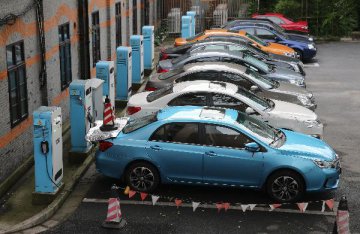
China's new energy vehicle (NEV) business is expected to phase into a booming development stage during the 13th Five-Year Plan period (2016-2020), thanks to the strengthening policies supports and soaring market demands. The Communist Party of China (CPC)'s fifth plenary session of its 18th Central Committee concluded on Thursday.
It outlined the 13th Five-Year Plan (2016-2020) for national development, which, experts and industry insiders believe, will take the NEV development as one of the priorities. China's automobile industry, comprising both fossil-fuel car business and NEV business, suffered declines in both sales and prices this year. The car output dropped 0.8 percent year on year in the first three quarters, to 17.09 million units; while the sales volume rose 0.3 percent year on year to 17.06 million units.
The two growth rates were much lower that those for the same period of 2014, when the output and sales grew 8.1 percent and seven percent year on year, respectively. However, China's car sales grew 2.1 percent year on year in September, which was partly attributed to the continuing expansion of China's NEV market by industry insiders. Statistics from the Ministry of Commerce show China's NEV sales skyrocketed 2.3-fold in the first three quarters of this year and hit a record high in September. In September, the NEV output doubled from that for the same period of 2014, to 32,800 units.
The dazzling performance of China's NEV business sector was mainly boosted by policy supports. By now, 12 Chinese ministries have issued more than 20 favorable policies, including the NEV subsidy scheme, the purchase tax exemption, the reduction of vehicle and vessel tax, the national science and technology major projects, the industrial technology innovation program, the national award for charging facility construction, the preferential electricity prices for NEV battery charging and swap, the administrative rules on new pure electric passenger car enterprises, the technical standard system for electric vehicles, and the financial supports for NEV popularization and application in 2016-2020.
The latest favorable policy is a requirement of the State Council, which issued on Sept. 29 asking local authorities to lift purchase restrictions and remove plate number-based traffic controls for NEVs. Beijing aborted license-plate lottery for NEV in the fifth allocation of car license plates this year, and granted license plates for NEV directly to all applicants instead on Monday as a response to the new policy. By now, China has established a complete policy support system for NEV development, covering automobile research and development, manufacturing, sales, using and supervision.
The policies have already brought the NEV business sector into a fast lane. Experts believe China's NEV output and sales will reach 350,000-370,000 units by the end of this year, and about 500,000 units by end-2016. As the United States saw a decline in NEV sales this year, China will rank the first by NEV output and sales in the world, said Wu Hui, an analyst with a research center under the Ministry of Industry and Information Technology.
Industry insiders forecast that the NEV business will make great-leap-forward development in the next few years and act as a new growth engine for China's automobile industry With the bright prospect, some experts forecast China's NEV business sector will change the operating model from policy orientation to market orientation in the next five to ten years. PwC's partner Jin Jun said of China's market demands for NEV is diverted from NEV buses for public transport and micro NEV cars to pure electric passenger cars. That indicates the NEV business has entered into the stage of market-oriented operation, he said.
Chen Dongsheng, secretary-general of a multimedia alliance under the National Development and Reform Commission, said a major task of the 13th Five-Year Plan is to maintain the sound operation of NEV industry in the circumstance of fewer subsidies or no subsidy. However, policy support is still a popular approach to boost NEV popularization worldwide. Norway, with the most electric vehicles in the world, exempts electric vehicles from highway tax, parking fees and road tolls and allows them to use bus lanes. Germany plans to provide free parking services and license plates for NEVs.
Netherlands provides tax preference ranging from 5,000 to 8,000 euros for each NEV. France also provides tax preference of 7,000 euros for NEVs. The United States provides tax deductions of 7,500 US dollars and 4,007 dollars for NEVs and a 30 percent subsidy to the investment in charging facilities. Miao Peng, an analyst with market researcher sci99.com, said China's NEV business sector will continue to be supported by favorable policies and rigid demands in the future, and keep its output and sales at high levels.
Huang Yan with Guotai Fund said the 13th Five-Year plan will create new opportunities for the capital to invest in NEV business. He said it is inevitable for NEVs to replace fossil-fuel cars in the future, because not only the technologies are maturing but also the government keeps boosting the NEV development. He predicts that the NEV manufacturing will become a backbone of China's economic growth. Despite of the recent sales surge, China still has difficulties to fulfill its target for NEV development on time, which is accumulating output and sales of pure electric vehicles and plug-in hybrid power vehicles to 500,000 units by 2015 and to more than five million units by 2020. As China's NEV development still falls behind the schedule, said PwC's partner Liao Zhongmin. "The government is expected to issue more supportive policies after 2015."
Industries > Consumer Products and Services




















Latest comments